Issue John, Prince of Girona Mother Marie of Orleans | Name Germaine Foix | |
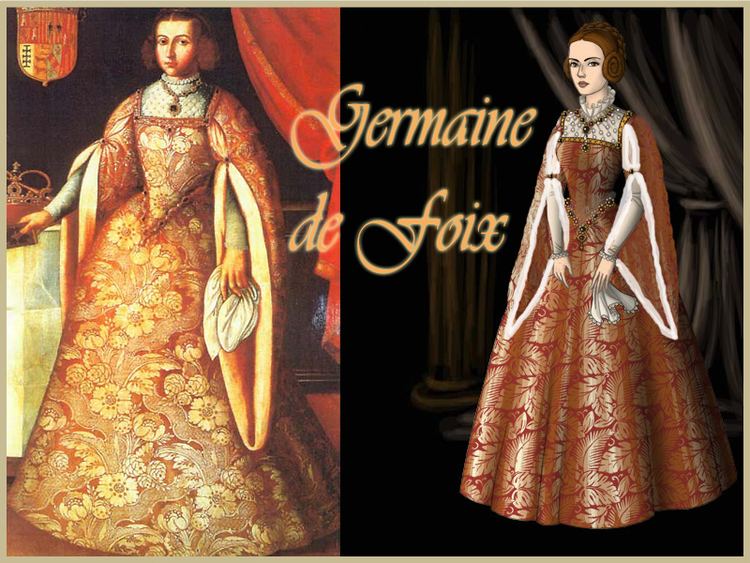 | ||
Tenure 22 March 1505 – 23 January 1516 Tenure 24 August 1512 – 7 June 1515 Burial Monasterio de San Miguel de los Reyes Children John, Prince of Girona, Isabel Parents John of Foix, Viscount of Narbonne, Marie of Orleans, Viscountess of Narbonne Similar People Ferdinand II of Aragon, Isabella I of Castile, Joanna of Castile, John - Prince of Asturias, John II of Aragon and Nava Queen consort of Aragon, Majorca, Valencia, Sardinia, Naples and Sicily Countess consort of Barcelona Queen consort of Navarre Tenure (24 August 1512 – 23 January 1516) Duchess consort of Calabria Tenure (August 1526 – 15 October 1536) Died 15 October 1536 (aged 48) Llíria, Valencia, Kingdom of Valencia Born c. 1488 Mazères(?), Kingdom of France | ||
King charles and germaine of foix have a child carlos rey emperador
Germaine of Foix (1488 – 18 March/October 1538) was queen consort of Aragon as the second wife of Ferdinand II of Aragon, whom she married in 1505 after the death of his first wife, Isabella I of Castile.
Contents
- King charles and germaine of foix have a child carlos rey emperador
- Isabella of portugal sends a letter to charles v with germaine of foix carlos rey emperador
- Queenship
- Death of Ferdinand and Succession of Charles
- Vicereine of Valencia
- References
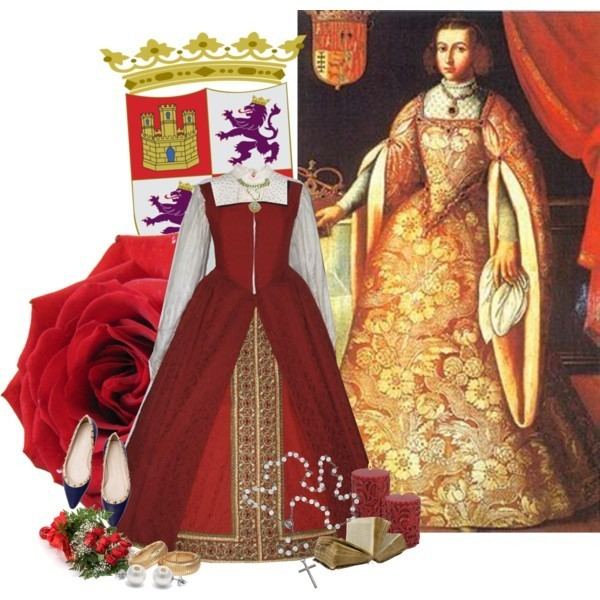
Germaine's father was John of Foix, Viscount of Narbonne and son of Queen Eleanor of Navarre. Her mother, Marie of Orléans, was the sister of King Louis XII of France.
Isabella of portugal sends a letter to charles v with germaine of foix carlos rey emperador
Queenship
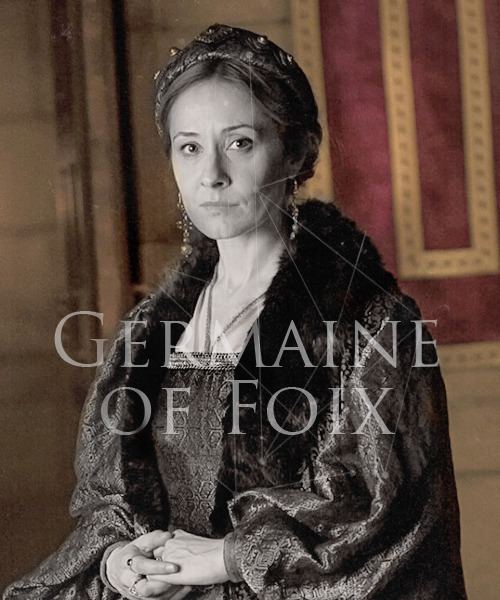
Following the death of his wife, Isabella I, Ferdinand had to yield the government of Castile to his son-in-law Philip of Burgundy (1478–1506), who assumed power in the name of his wife Joanna (1479–1555), Isabella's heiress. Ferdinand objected to Philip's policies and to prevent Philip from gaining Aragon through Joanna, he sought to have a male heir with a new wife. A new male heir would displace Joanna (and by extension her husband) from the line of succession. He negotiated with King Louis XII of France for a marriage, hoping to gain accession to the throne of Navarre. At the Treaty of Blois, Louis agreed to have his niece Germaine of Foix marry Ferdinand; Germaine was Louis' niece (daughter of his sister) and Ferdinand's grandniece (granddaughter of his half-sister). Louis XII also ceded in the treaty his weak claim to the Kingdom of Naples (already controlled by Aragon) and Kingdom of Jerusalem (controlled by neither) to his niece, conditional on a male child being produced. The marriage, between Ferdinand (aged 54) and Germaine (aged 18), took place in March 1506. A short truce and brief alliance between the two kings resulted, despite several wars before and after the Treaty.

In 1506 Philip of Burgundy died and Ferdinand became regent of Castile for his mentally unstable daughter Joanna. Ferdinand and Germaine did have a son, John, Prince of Girona on 3 May 1509, but he died shortly after birth. Despite the use of love potions, they did not have another. If John had lived, then the Crown of Aragon would have split from the Crown of Castile once again (after being semi-unified by Ferdinand and Isabella's marriage). This included Aragon, Valencia, Majorca, and Catalonia in Spain, and the Kingdom of Naples, Sicily and Sardinia in the Italian peninsula and the Tyrrhenian Sea. With Juan's death, both Castile and Aragon would eventually go to Ferdinand and Isabella's daughter Joanna.
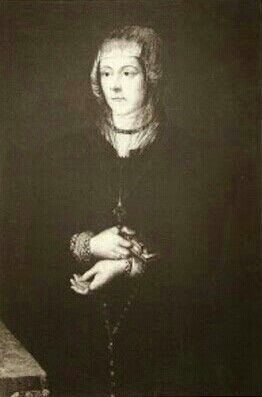
Ferdinand's diplomatic deviousness and off and on alliances with France infuriated Henry VIII of England (born 1491, reigned 1509–1547), married to Ferdinand and Isabella's youngest daughter, Catherine of Aragon (1485–1536). Seeing this match devalued, Henry in 1514 forced his sister Mary (1496–1533) into a loveless marriage with Louis XII to spite Ferdinand. Louis XII died the next year.
Death of Ferdinand and Succession of Charles
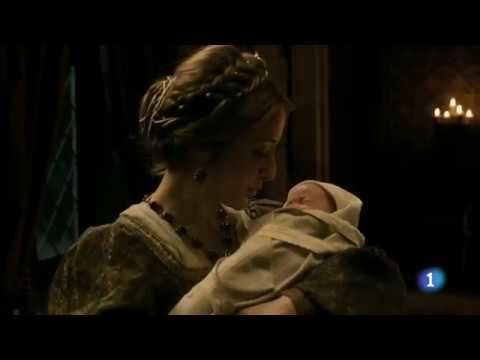
Ferdinand died after two years of health problems in 1516, leaving Germaine a widow. Ferdinand's successors were Joanna and her son Charles. Ferdinand did, however, leave Germaine a yearly income of 50,000 gold florins, and exhorted his grandson Charles in his last letter not to abandon her.
In 1517, Charles moved from the Netherlands to Castile as the new King of Castile and Aragon. Germaine moved from Aragon to Castile to join his court as well, where the 17-year-old king took well to his 29-year-old stepgrandmother. He organized several tournaments and banquets in her honor. On 20 August 1518, Germaine gave birth in Valencia to a daughter, Isabel. It is widely speculated among historians that Charles was Isabel's father; Germaine refers to her in her will as the "Infanta Isabel" — a title that only makes sense if her father was the King, and her father as "The Emperor"
Charles, Germaine, and Charles's sister Eleanor moved from Castile to Aragon in 1519, where he would be formally sworn in as King of Aragon. He would spend a year in Aragon, negotiating with its parliament and managing affairs. While in Barcelona, Charles arranged for Germaine to marry the margrave Johann of Brandenburg-Ansbach, a landless cadet and cousin of Joachim I, Elector of Brandenburg. Germaine left Spain to travel with Charles to Germany, where she was married.
Vicereine of Valencia
In 1523 Charles appointed the couple jointly viceroys of Valencia. There Germaine, recently returned to Spain, dealt with the fallout of the Revolt of the Brotherhoods by the Valencian guilds (Germanies). Germaine favored harsh treatment of the agermanats; she is thought to have signed the death warrants of 100 former rebels personally, and sources indicate that as many as 800 executions may have occurred in total. This undid the more lenient policy of Diego Hurtado de Mendoza, who had favored reconciliation with the rebels. In December 1524, Germaine signed a pardon that officially ended the persecution of all former participants in the rebellion. However, fines imposed on the guilds and guild-aligned cities as punishment would take many years to be repaid.
It is acknowledged by Valencian historians that the fact that Germaine moved her court to Valencia was the first step in the degradation of social prestige of the Valencian/Catalan language in the Kingdom of Valencia, as the higher classes started favouring Castilian/Spanish over their native language to please her.
On Johann's death in 1526, Germaine married Ferdinand of Aragón, Duke of Calabria, a son of King Frederick IV of Naples (1496–1501) by his second wife Isabella del Balzo. The two continued as viceroys of Valencia and were patrons of the arts and music. Germaine also encouraged the slow integration of Valencia with Castilian-dominated Spain as a whole.
Germaine died on 18 March 1538 in Liria, propably due to obesity related edema, and was interred in the Monastery of San Miguel de los Reyes. The Duke of Calabria continued in office until his death in 1550.
